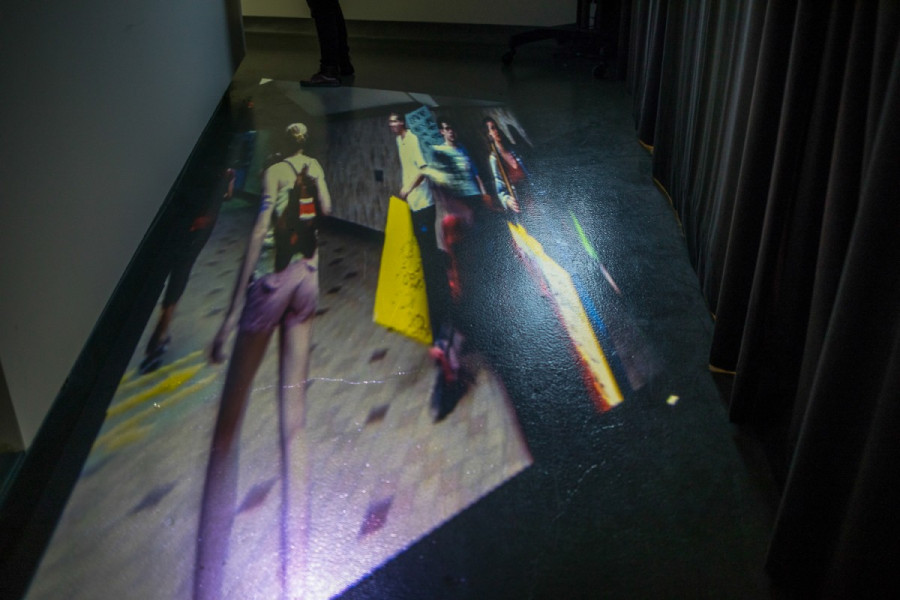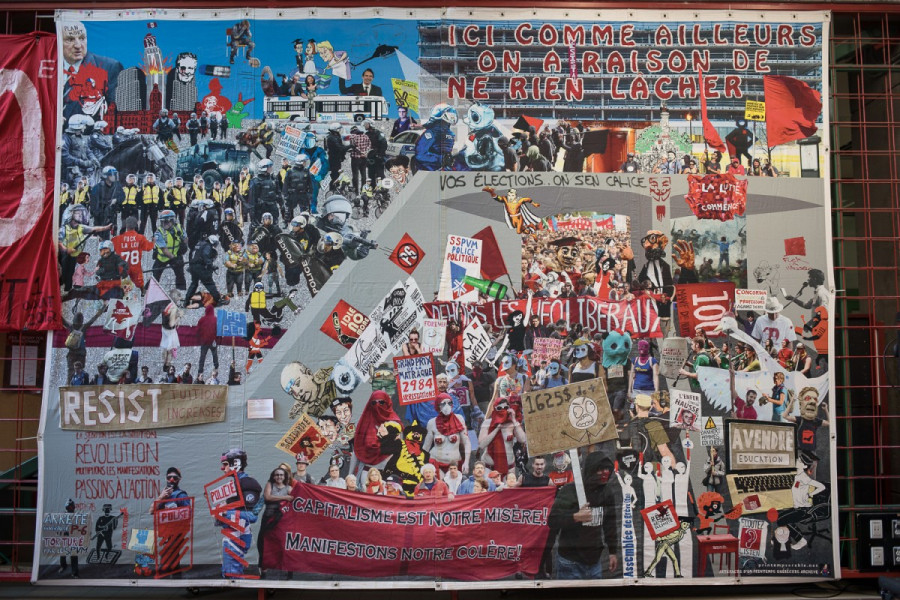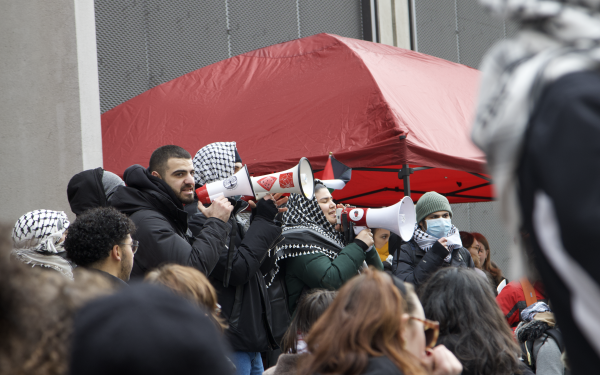The Highs and Lows of the 2012 Student Strikes
One Exhibit Examines the Emotions Behind the Movement
“I remember that evening, after the giddy thrill of the day had left, I cried. I cried in frustration and isolation, because we were taunted and scorned as immature fools and idiotic dreamers. I cried from exhaustion, because day after day in front of classroom doors we were met with hostility and rage, pushed and shoved, called thieves by the people I now have to sit next to.”
–Diary of Keara, an undergraduate student in geography and environment at Concordia during the 2012 student strike.
“It was beautiful, it was like a dream, it felt surreal,” says Nadia Hausfather when she recalls interviews she collected during the 2012 student strike against tuition hikes.
Throughout Wednesday and Saturday the 2012 Quebec student strike was revisited in the LB Building, in collaboration with Concordia’s Centre for Oral History and Digital Storytelling and the Curating and Public Scholarship Lab.
At the forefront of the exhibit was a look into Hausfather’s thesis on general unlimited student strike movements in Quebec between 2005 and 2012.
The Striking Memories exhibit showcased highlights of the strike with collections of banners, photos, videos and documentaries from over the years, as well as excerpts of interviews from participants at the time.

“It’s about student strikes, what it takes, what’s involved and what you leave behind as you fight,” said Rushdia Mehreen, who helped develop the exhibit and participated in the movement when she was a geography, planning, and environment masters student at Concordia.
The 2012 strike was the largest unlimited student strike in Quebec history and a historic moment for Concordia since it was the first the English university to join the strike.
In 2012, the Liberal government tried to raise domestic tuition from $2,168 to $3,793 by 2018; though their efforts were later squashed as student strikes erupted across the province. A large part of the movement ran out of Montreal’s universities. Half of the student population went on strike in April of 2012 and a quarter million students took part in the movement’s height.
The Concordia Student Union and Graduate Student Association both called strikes throughout, along with departments like engineering and computer science on the graduate level and geography on both the graduate and undergraduate level. Hausfather recounted how undergraduate geography students were able to block classrooms in their department for eight weeks.
As the Parti Québécois ran on an election promise to not raise tuition and gained power in September of 2012, strikes dwindled as the new government demanded only small increases in Quebec tuition tied to the cost of living.
Hausfather herself participated in the movement with Concordia’s GSA and a strike coalition organized by ASSÉ, Association pour une solidarité syndicale étudiante, an association that mobilized mass strikes throughout 2012.
While student’s anger was generally the focus in the mainstream media, Hausfather’s interviews with participants of the 2012 strike showed that there was rarely a pattern of anger among activists.
“What I noticed was that people tended to talk about, especially at the beginning of the strike, these really intense and enjoyable highs. [At times] aesthetically beautiful experiences, related to emotions that were associated to the collective.” – Nadia Hausfather
“I was already interested in studying emotions, so I wanted to focus on emotions that were brought up during the student strikes in Quebec. So in 2011 I started interviewing people who participated in the 2005 and 2007 general unlimited strike campaigns, and then after 2012 I interviewed people who were involved in what happened in 2012,” Hausfather told The Link.
This year Hausfather’s thesis was granted an award for excellence in oral history by the Centre for Oral History and Digital Storytelling.
“What I noticed was that people tended to talk about, especially at the beginning of the strike, these really intense and enjoyable highs,” Hausfather explained. “[At times] aesthetically beautiful experiences, related to emotions that were associated to the collective.”
But with the positive emotions also came negative ones, she said, and emotional highs and lows were at times experienced within short spans of minutes.
“A lot of the collective emotions in the beginning gave people an existential purpose,” Hausfather said. “[Those experiences] were followed by negative emotions and a lack or loss of purpose.”
“Going from complete empowerment to complete disempowerment in the span of minutes after experiencing police brutality,” she explained. “There was fatigue, depression, sometimes burnout […] Especially for those most involved.”
Fear was also dominant and Hausfather said some participants were even left traumatized.
“I did not participate in the night marches because I was really scared and that fear only increased when I started hearing stories of people that had been mistreated by police,” said Florencia Marchetti, who contributed to the exhibit and likened the 2012 strikes to experiences she had growing up in Cordoba, Argentina during political upheaval.
“I was biking one night and I saw a police car parked and I became really scared thinking that if they saw my red square on my backpack they could chase me or stop me and question me and do anything, like kidnap me,” Marchetti continued.“It really affected my body in a very intense way and I couldn’t shake that feeling for days.”
A large portion of the archives in the exhibit were also provided by David Widgington, whose collage of the 2012 strike was the largest piece of the exhibit. It displayed collages of riot police as well as demonstrations against Montreal’s P6 bylaw–a law that temporarily banned protesters from covering their faces at demonstrations.
“He was basically taking stuff from during the strike, archiving them all,” explained Mahreen. “He did it all by himself.”
Mehreen also presented a wide variety of paintings she created throughout the 2012 strike. They showcased her emotional state during the strikes, and some of her thoughts on what was lacking in the movement. In one piece, showing a collection of red squares on a white background, the phrase “So White” could be read.
“It was a critique of the movement,” she said. “We wanted there to be more to it.”
At times the exhibit was collaborative and performance art was often integrated throughout the week. Poems were read through megaphones and attendees were invited to dress in red and lie on the floor so a red square could be formed on the ground–reminiscent of a tactics used throughout the strike to attract the attention of the media.
Attendees could add lines to a manifesto being written as part of a performance, and one board allowed students to write their memories of the strike on top of red squares–with one student writing that “Gabriel Nadeau-Dubois is rat bastard who sold out our struggle!”
To learn more about Hausfather’s thesis “Ghosts in our corridors: Emotional experiences of participants in Quebec’s general unlimited strike campaigns (2005-2012)” you can visit ActivisteMotions.net.




__thumb_600_375_90_s_c1.JPG)
_(1)__600_375_90_s_c1.jpg)